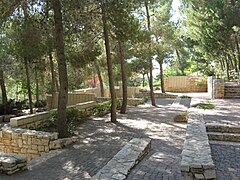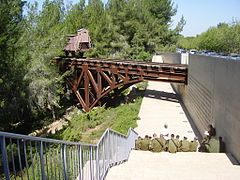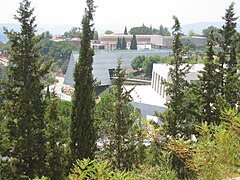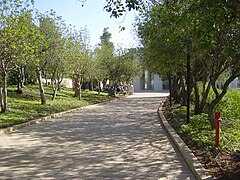
Back Õiglaste allee Estonian גן חסידי אומות העולם HE Giardino dei Giusti Italian De rättfärdigas trädgård Swedish
| The Garden of the Righteous Among the Nations | |
|---|---|
| Yad Vashem | |
 The Garden of the Righteous with Wall of Honor in the background | |
 The Cattle Car Memorial to the Deportees adjacent to the Garden of the Righteous | |
 Panorama of Yad Vashem complex.[1] | |
 The Avenue of the Righteous |
The Garden of the Righteous Among the Nations (Hebrew: גַן חֲסִידִי אוּמות הָעוֹלָם) is part of the much larger Yad Vashem complex located on the Mount of Remembrance in Jerusalem. Along with some two dozen different structures within the Yad Vashem memorial – which is the second most-visited destination in the country after the Western Wall – the Garden of the Righteous is meant to honor those non-Jews who during the Holocaust risked their lives to save Jews from extermination by the Nazis.
The Garden was designed by landscape architects Lipa Yahalom and Dan Zur after a decision to construct a memorial where the names of the Righteous Among the Nations would be perpetuated. A most serene site of impressive simplicity, integrated into the natural surroundings of the forested hill, the Garden consists of a series of walls creating open rooms, where the names of all the Righteous who had no trees planted in their honor are engraved in alphabetical order on the walls according to their countries of origin. By the time the Garden was dedicated on August 7, 1996, close to 14,000 Righteous had been honored by Yad Vashem. Since then new names are being added every year. In 2011, the Garden was expanded and new walls were constructed.[1][2][3][4]
The entire site receives one million visitors annually.
- ^ a b Cite error: The named reference
panoramawas invoked but never defined (see the help page). - ^ Cite error: The named reference
MFAArchivewas invoked but never defined (see the help page). - ^ "Map of Yad Vashem". yadvashem.org. Retrieved 5 August 2019.
- ^ "The Garden of the Righteous Among the Nations". yadvashem.org. Retrieved 5 August 2019.